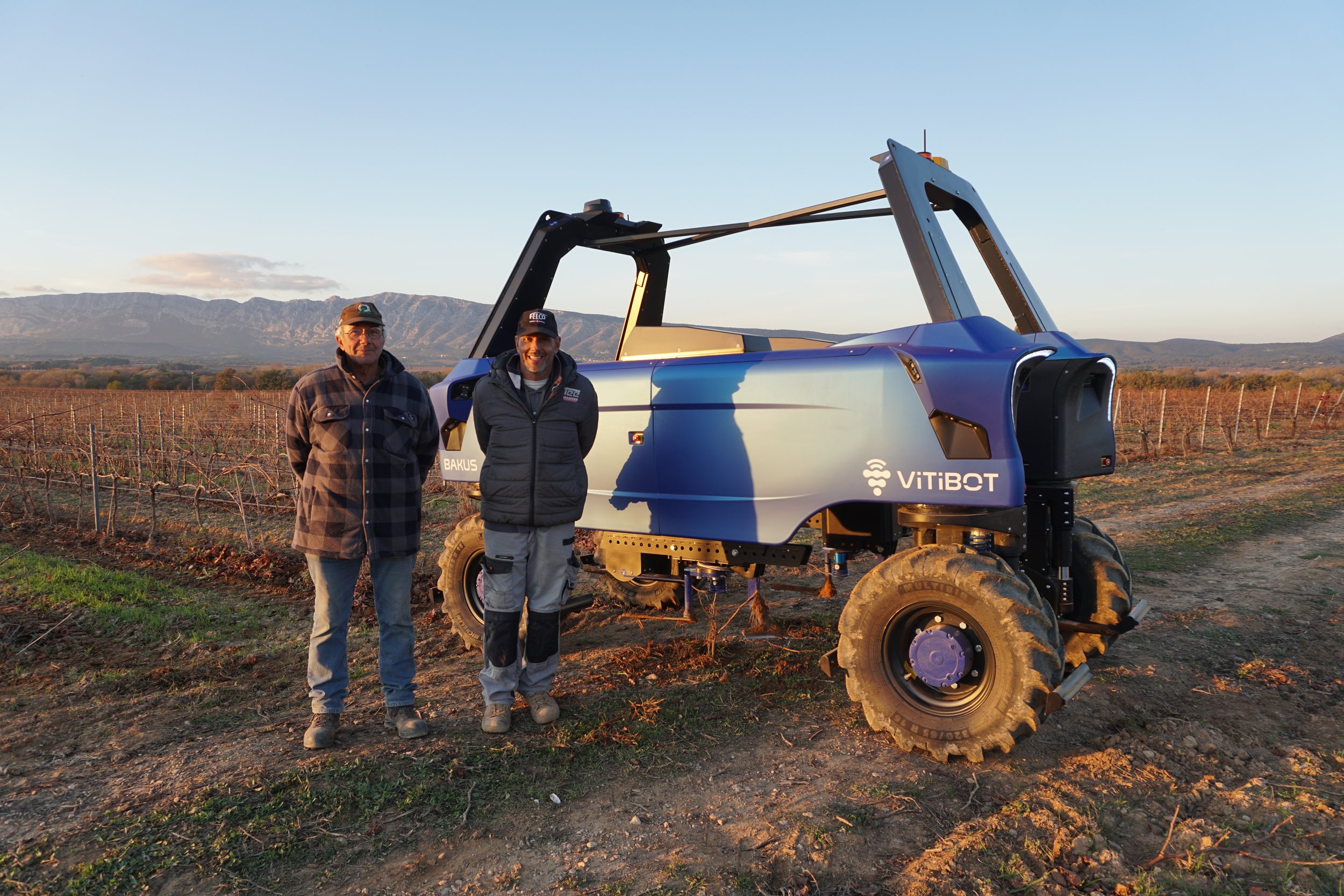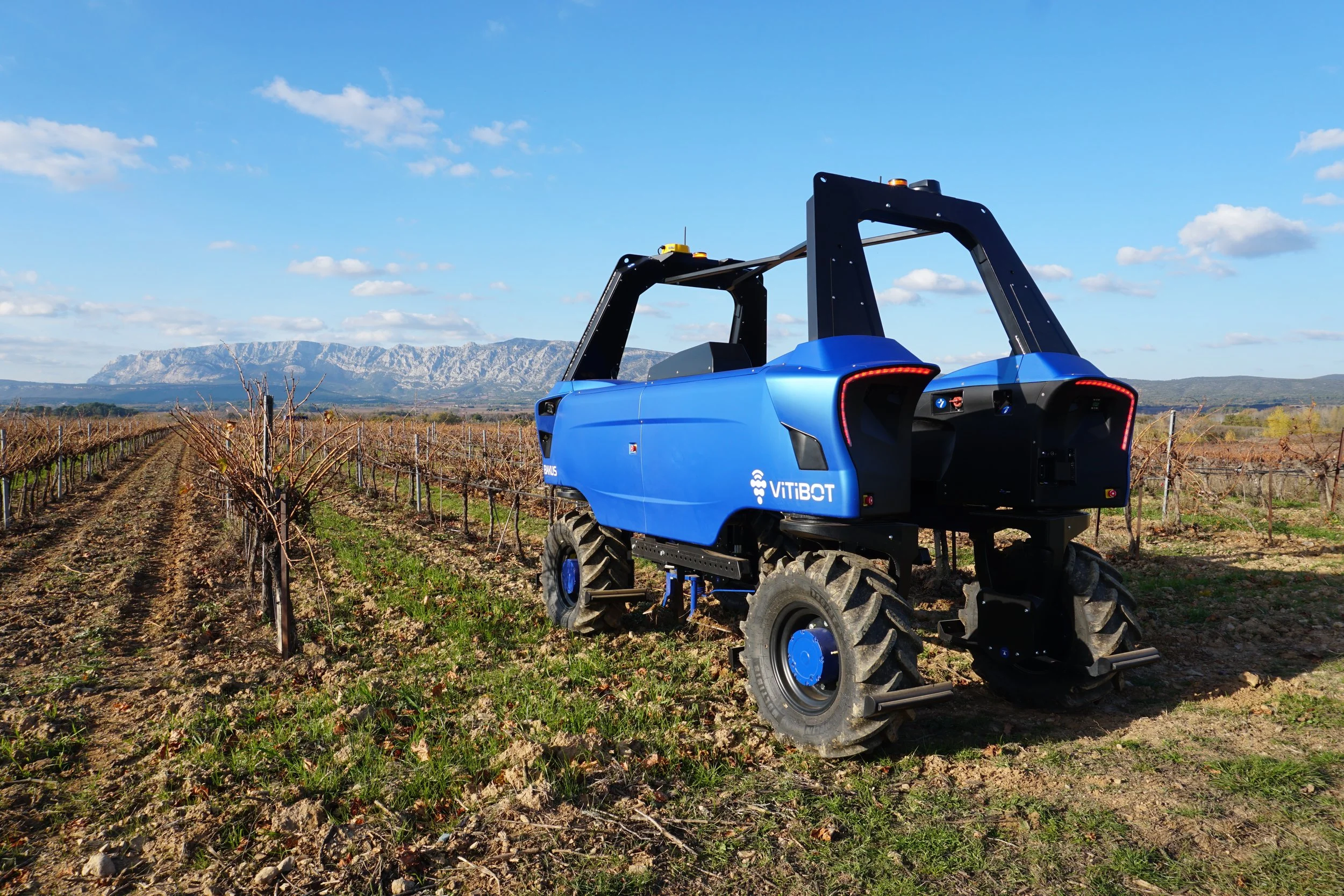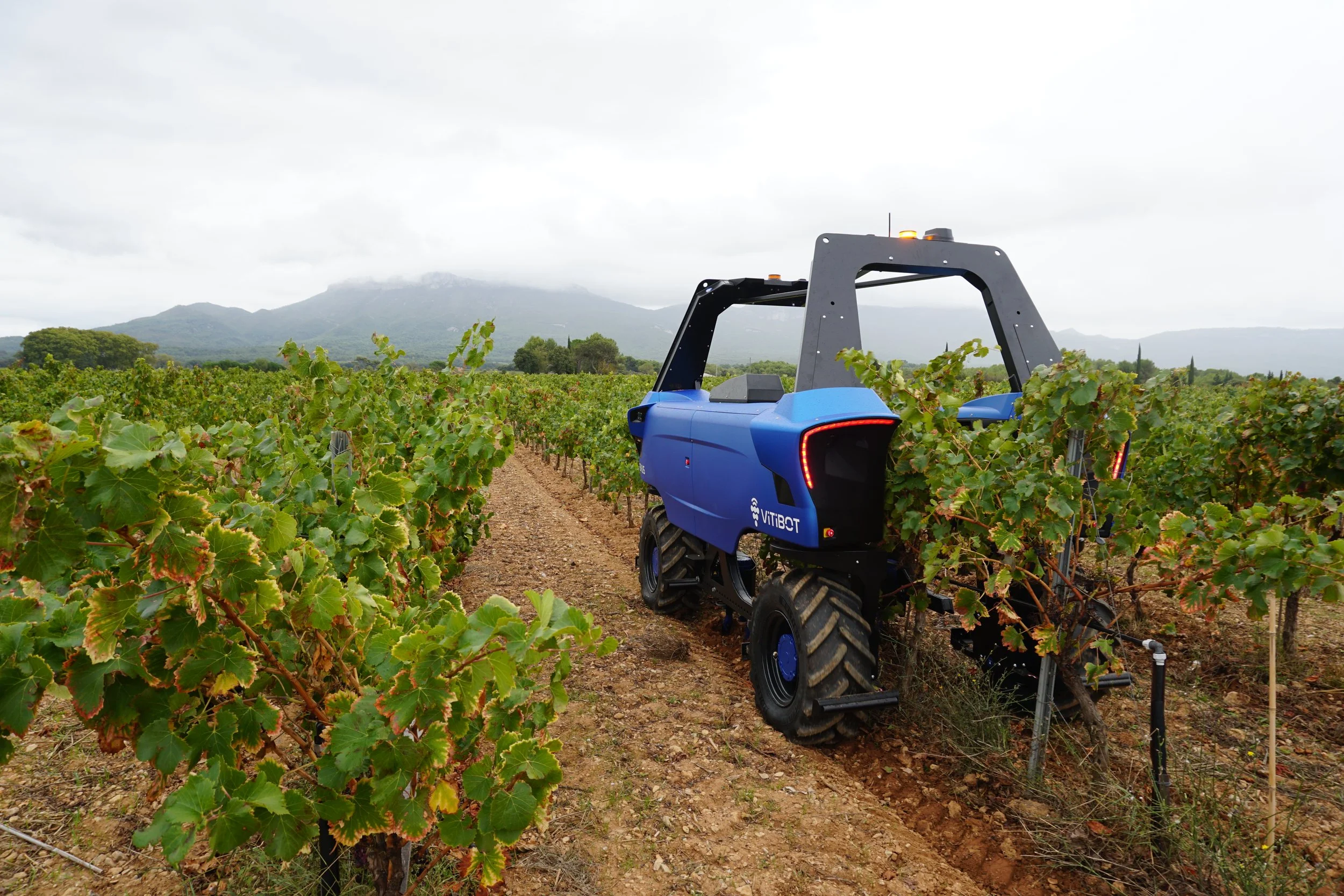Robot Bakus in the vineyard : Save time by automating soil cultivation
“I have the control of my time again”
Before starting this interview and if you are intersting to better understand the French vineyards and its challenges, I have writing an article that will explain you its evolution and its opportunities : EXPLORATION OF THE FRENCH VINEYARD
Presentation of the user and its machine
Yannick Robiglio, 49 years old, is winegrower with more than 15 years of experience in vineyards. In 1998, he settled with his father on a domain located in Trets, in the Bouches-du-Rhône region, France. In 2011, he took over the family domain and manages now 50 hectares of vineyards and 30 hectares of diverse field crops and hays, both in conventional farming. Certified High Environmental Value (CHE), he strives to work as cleanly as possible. He is also committed with the association of the “Vignerons de la Sainte-Victoire” in the reduction of inputs, and he is no longer using chemical solutions to weed his fields.
In November 2020, Yannick decided to invest in a Bakus L manufacturer by the French company VITIBOT. He purchased it for 180 000 € to replace him and his tractor on all soil cultivation tasks on 35 ha of vineyards. In 2021, the robot was equipped with electric intervines and has worked the soil for 140 hours. For 2022, it will be equipped with Kress Fingers and crumbling discs too.
Yannick on the right, and his father on the left, Photo from Vitibot.
Why have you invested in robotics? Did you receive any grants?
First, I have a bachelor in mechanics, and I spent several years of my life as a mechanical designer, new technologies and techniques have always attracted me.
Then, the shortage of farm workers is more and more felt in the region. It is impossible to find qualified and motivated tractor operators. As a result, I was doing the repetitive and time-consuming task like soil cultivation, and I dreaded this moment every year. Since then, with the robot's work rate, I manage to be 2 months ahead of my weeding season, I do not run after time anymore and do not consider this task as a burden. By delegating the tillage to this machine, it allowed me to gain flexibility and free up my time for other more rewarding tasks.
From an economic point of view, I did not take the necessary steps to receive any grants. Even if this machine has a cost, it saves me from hiring a tractor driver, with the numerous charges that go with it. So, while preparing this investment, I studied the gains in time and money that this machine could bring me, and the project was clearly profitable.
How did you know which robot technology was best for your vineyard?
Between the moment I thought of investing in robotics and the moment I bought a robot, it took between 2 and 3 years. This kind of product is new on the market, so you have some doubts at the beginning, that is why it is important to prepare the project well and choose the product that is best adapted to your farm. At the beginning, I was thinking about robotizing the weeding of my iris production, a smaller project, but I realized that it was more interesting to invest in the vineyard.
I met the two main French manufacturers of robotics at SITEVI in 2019. After discussing with them, I asked to test their machines on my vineyard. The objective was to put them in real conditions, see their capacity and how I could use them on my vineyard. The first company came for a demonstration summer 2020 and the second few months later. The demonstrations took place on 5 hectares. After seeing the two machines turned, I chose the one that seemed to me the most successful and the most adapted to my vineyard.
Robot equipped with its electric intervines, Photo from Vitibot
How did you learn to use the robot? How long did it take you to feel autonomous?
I had already had the opportunity to use the machine during the demonstration. When the robot was delivered, a 3-day training session with an expert took place. During this training, we review together the key points around the use of the robot, the security, the programming, apprehension of the machine's reactions... The manufacturer also takes advantage of this to carry out the cartography of the parcels.
May be my technical background helped me, but after 2 hours of use, I was already autonomous on the machine. These machines seem complicated on the surface, but it is disconcertingly easy.
Reception of the machine and training with an expert, Photo from Vitibot
How was the start-up of the machine, the good and the bad ?
Since I had already seen the machine running on my domain, I knew what it was capable of before it was officially started. From memory, a few electronic components failed but were quickly changed, otherwise no major failure. As with any start-up, there were a few days of adjustment and calibration to be done so that the machine was perfectly autonomous in my fields. That is why it was important to have an expert on site the first few days, just to settle these details and to be able to run the machine as quickly as possible.
This year, I am a little bit late on my season. Indeed, I decided to install new tools on the robot to work the soil and relieve me of even more work. Like any change, it took a little time to find the right tools and the right configuration to install them on the machine. We are still working on it, but I am not worried, I know the robot will catch up quickly.
How are the service and maintenance organized ?
This was one of the important points I wanted to make before investing. By investing in such technology, I was aware that unforeseen problems could arise during its use, so it was essential that the manufacturer be reactive.
We pay a 4500€ year subscription. For that price, the manufacturer provides the GPS and other telecommunication subscription, a free telephone hotline that we can call at any moment, software updates and personalized assistance. In most cases, the teams have real-time feedback on my machine. They can analyze the issues quickly, take control of the robot and correct it remotely, sometimes even before I see the breakdown. And if the problem persists, the manufacturer sends its distributor on site to solve it, it can take half a day to a day to be repaired.
How did you adapt your vineyard and your growing methods to integrate the robot ?
The modifications to my plots were minimal knowing that I was already used to cultivate the soil with the tractor and with mechanical intervines. I still had to protect the drip system and the few boundaries present in my plots, to avoid tearing them up. I also shortened some rows to give the robot enough space to make its turns, nothing very costly.
As for my working methods, I think they are much less restrictive than before. The robot allows me to work the soil at 4-5 km/h, which is twice as fast as with the tractor. So my planning is much more flexible than before. Since the more the robot works, the more profitable it is, I make more passes and more regularly.
When the robot is working, I can also devote myself to other tasks in the same plot of land while monitoring it, I make phone calls, I do some trellising, I prune... I am kind of back in control of my time.
The robot working in autonomous mode, Photo from Vitibot
How do you use the robot ? How many hours ? Have you noticed any evolution on the machine since the beginning ?
The more it works, the faster it pays for itself.
In only one year, the machine has already made a lot of progress, especially thanks to its regular version updates. It turns twice faster in the half-turns, the reliability has clearly improved with less stops than at the beginning. It happens that the machine runs for 6 hours without my intervention. Of course, everything is not yet perfect, but it is progressing very quickly!
In 2021, the machine performed about 140 hours of tillage with its electric intercepts, which is equivalent to 280 hours of tractor time saved. It has worked on 35 hectares of plots, making between 3 to 5 passes per plot depending on the weed pressure in each plot.
For this season, I would like the robot to take over the tillage with crumbling discs and Kress fingers, which would allow me to save even more tractor hours. The objective is to continue to delegate tasks to the robot, to make it work as many hours as possible and on as many hectares as possible.
How do you imagine your robot evolving and improving in the next years? Are you thinking of automating other tasks?
I no longer forbid myself anything.
In the short term, I would like the robot to do 100% of the soil work on the 35 hectares of the domain, which from my point of view is the most time-consuming task. And why not make it work on more hectares in the next few years since I am currently thinking of expanding the domain.
Initially, I had in mind that the robot would only work the soil. But I know that the manufacturer is working on a confined spraying system and that it is progressing well. In the end, the more I use the robot and the more I think about automate the spraying.
In the longer term, there are also other time-consuming tasks that I would like to automate. For the moment, these are only ideas, but once we have automated the soil cultivation, we will turn to other tasks.
What advice would you give to other farmers who are considering buying a robot?
Be well informed.
It is hard to give advice, I think every project is different. The only advice I can give is to be well informed, ask questions to other users and to manufacturers. Do not hesitate to test the various solutions on the market in real conditions and if possible, on your own plots. This allows you to check that you are comfortable with the machine and to get you an idea of its potential. According to me, this stage of preparation of the project is essential to know on which surface and on which part of the domain you will be able to use the machine.
Cultivation of the soil in weedy conditions, Photo from Vitibot
Are there any other technologies that you are particularly looking forward to ?
Always stay open.
I am always looking for new solutions that can simplify my work. In any case, I think that we must stay open and continue to evolve, that is the key.
Now, I am looking to mechanize the pruning of my vines. I have seen that precision pruning solutions already exist on the market, I need to see it at work. I am also looking at everything that is being done in terms of sensors, drones, and data collection, but it is not a priority for the moment. Regarding frost and hail, I have also looked at different systems to counter them, but so far, I am not convinced by one solution more than the other, I am waiting to see their evolution.
Bakus on his trailer, ready to work. Photo from Maxence
WANT TO LEARN MORE ABOUT TECHNOLOGIES AND THEIR EVOLUTION, THESE MAY HELP YOU !
Want to better understand new agricultural technologies ?
What do other farmers think about new technologies and investment ?
The Family Farm | Conventionnal Field Crops Farms in France
Robot in the vineyard : Replace Glyphosate robotic soil cultivation | French wine grower experience with a robot








